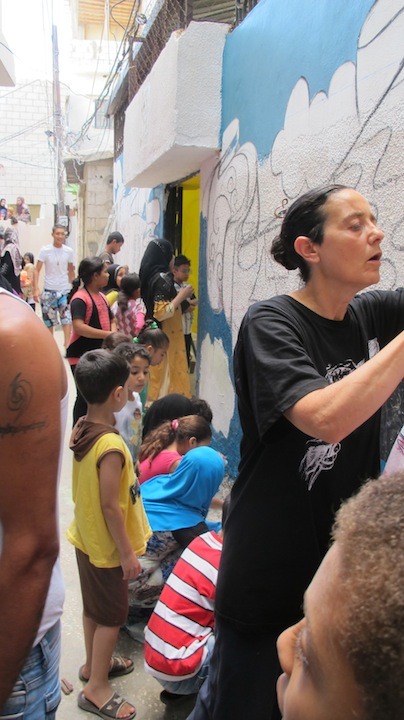 Posted by Fred Alvarado
Posted by Fred Alvarado
Abu Fadi jokes around as we shuffle through the passage ways and streets of the camp. We move from one space to another. We eat with families and chat with youth. Abu Fadi understands English. He listens and responds patiently as we ask questions. He is one of the elders at the Bourj El Shamali camp, responsible for organizing this community mural project at the Al Hooleh, (Memorial site). Abu Fadi and his wife, Um Fadi, had 12 children. In June of 1982 a phosphorus bomb detonated in a kindergarden, killing 96 children. Six of their children where born after the horrific events that took place at the camp. Their other 5 children were incinerated by a combination of chemical weapons in the Zionist siege of the camp. During the attack most men where killed or incarcerated, leaving the women to fend for their families. We are painting a mural commemorating the space, highlighting the resilience and strength of this community.
We have been painting with the community of Bourj El Shamali. A mix of feelings and thinking occur while smelling the cigarette smoke and exhaust fumes coming from children on swooped up motor scooters. The painting is going slow but steady. Folks seems to like the painting so far even though it is missing key visual elements to the Palestine camp narrative. Intrigued by the color and difference in style, community members ask questions.
I hear folks joking but can’t understand the punch lines.
The reality of being half way around the world painting in a memorial site, is all at once surreal and grounding. I don’t know if to laugh or cry.
The site, the actual sight of the massacre, a grave yard in the middle of a camp is filled with survivors, witnesses, and newer generations. Memories of unthinkable actions that remain on replay as anniversaries pass. Abu Fadi and his family lives here. Although the surroundings are part of his everyday, I wonder when and how did he get past this horrendous event? He lost 5 children at this site. He takes care of this site, nurturing and building it. There is a monument created in remembrance to the children and other civilian martyrs. Preschool aged children. Little pip squeaks like the ones who talk to me as I paint the front facade of the building. While this camp is one of the poorest in Lebanon, it is clean with a homey feel, filled with happiness and wonder. The children go to school and eat popsicles. They are interested in the foreigners and visitors. They are welcoming. Along with the children, there are also groups of youth. ‘At risk’ one might say, at risk of drugs, teenage pregnancy, wars…Reminiscent of the students I have work with in the S.F. Bay Area. I connect through example, I see how Abu Faddi treats them. Respecting their space. I work hard and ask for help. Lots of helping hands in this crowded camp. Families treating us to coffee, teas, breads, and smiles.
